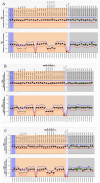Beckwith-Wiedemann syndrome mimicking the classical form of congenital adrenal hyperplasia in newborn screening
- PMID: 38427811
- PMCID: PMC10948032
- DOI: 10.20945/2359-4292-2022-0395
Beckwith-Wiedemann syndrome mimicking the classical form of congenital adrenal hyperplasia in newborn screening
Abstract
Beckwith-Wiedemann syndrome (BWS) is a common genetic congenital disease characterized by somatic overgrowth and its broad clinical spectrum includes pre- and post-natal macrosomia, macroglossia, visceromegaly, increased risk of neonatal hypoglycemia, and development of embryonic tumors. BWS occurs due to genetic/epigenetic changes involving growth-regulating genes, located on region 11p15, with an important genotype-phenotype correlation. Congenital adrenal hyperplasia (CAH) comprises a spectrum of autosomal recessive diseases presenting a variety of clinical manifestations due to a deficiency in one of the enzymes involved in cortisol secretion. Early diagnosis based on newborn screening prevents the adrenal crisis and early infant death. However, high 17-hydroxyprogesterone (17-OHP) levels can occur in newborns or premature infants without CAH, in situations of stress due to maternal or neonatal factors. Here, we report new cases of false-positive diagnosis of 21-hydroxylase deficiency during newborn screening - two girls and one boy with BWS. Methylation-specific multiplex ligation-dependent probe amplification revealed a gain of methylation in the H19 differentially methylated region. Notably, all three cases showed a complete normalization of biochemical changes, highlighting the transient nature of these hormonal findings that imitate the classical form of CAH. This report sheds light on a new cause of false-positive 21-hydroxylase deficiency diagnosis during newborn screening: Beckwith-Wiedemann syndrome.
Conflict of interest statement
Disclosure: no potential conflict of interest relevant to this article was reported.
Figures

Similar articles
-
Analysis of the methylation status of the KCNQ1OT and H19 genes in leukocyte DNA for the diagnosis and prognosis of Beckwith-Wiedemann syndrome.Eur J Hum Genet. 2001 Jun;9(6):409-18. doi: 10.1038/sj.ejhg.5200649. Eur J Hum Genet. 2001. PMID: 11436121
-
High frequency of non-classical congenital adrenal hyperplasia form among children with persistently elevated levels of 17-hydroxyprogesterone after newborn screening.J Pediatr Endocrinol Metab. 2019 May 27;32(5):499-504. doi: 10.1515/jpem-2018-0398. J Pediatr Endocrinol Metab. 2019. PMID: 31028712
-
High frequency of copy number variations (CNVs) in the chromosome 11p15 region in patients with Beckwith-Wiedemann syndrome.Hum Genet. 2014 Mar;133(3):321-30. doi: 10.1007/s00439-013-1379-z. Epub 2013 Oct 24. Hum Genet. 2014. PMID: 24154661
-
Beckwith-Wiedemann syndrome: Clinical, histopathological and molecular study of two Tunisian patients and review of literature.Mol Genet Genomic Med. 2021 Oct;9(10):e1796. doi: 10.1002/mgg3.1796. Epub 2021 Sep 12. Mol Genet Genomic Med. 2021. PMID: 34510813 Free PMC article. Review.
-
Beckwith-Wiedemann Syndrome Review: A Guide for the Neonatal Nurse.Neonatal Netw. 2017 May 1;36(3):129-133. doi: 10.1891/0730-0832.36.3.129. Neonatal Netw. 2017. PMID: 28494824 Review.
References
-
- Brioude F, Kalish JM, Mussa A, Foster AC, Bliek J, Ferrero GB, et al. Expert consensus document: Clinical and molecular diagnosis, screening and management of Beckwith-Wiedemann syndrome: An international consensus statement. Nat Rev Endocrinol. 2018 Apr;14(4):229–249. doi: 10.1038/nrendo.2017.166. - DOI - PMC - PubMed
Publication types
MeSH terms
Supplementary concepts
LinkOut - more resources
Full Text Sources
Medical
